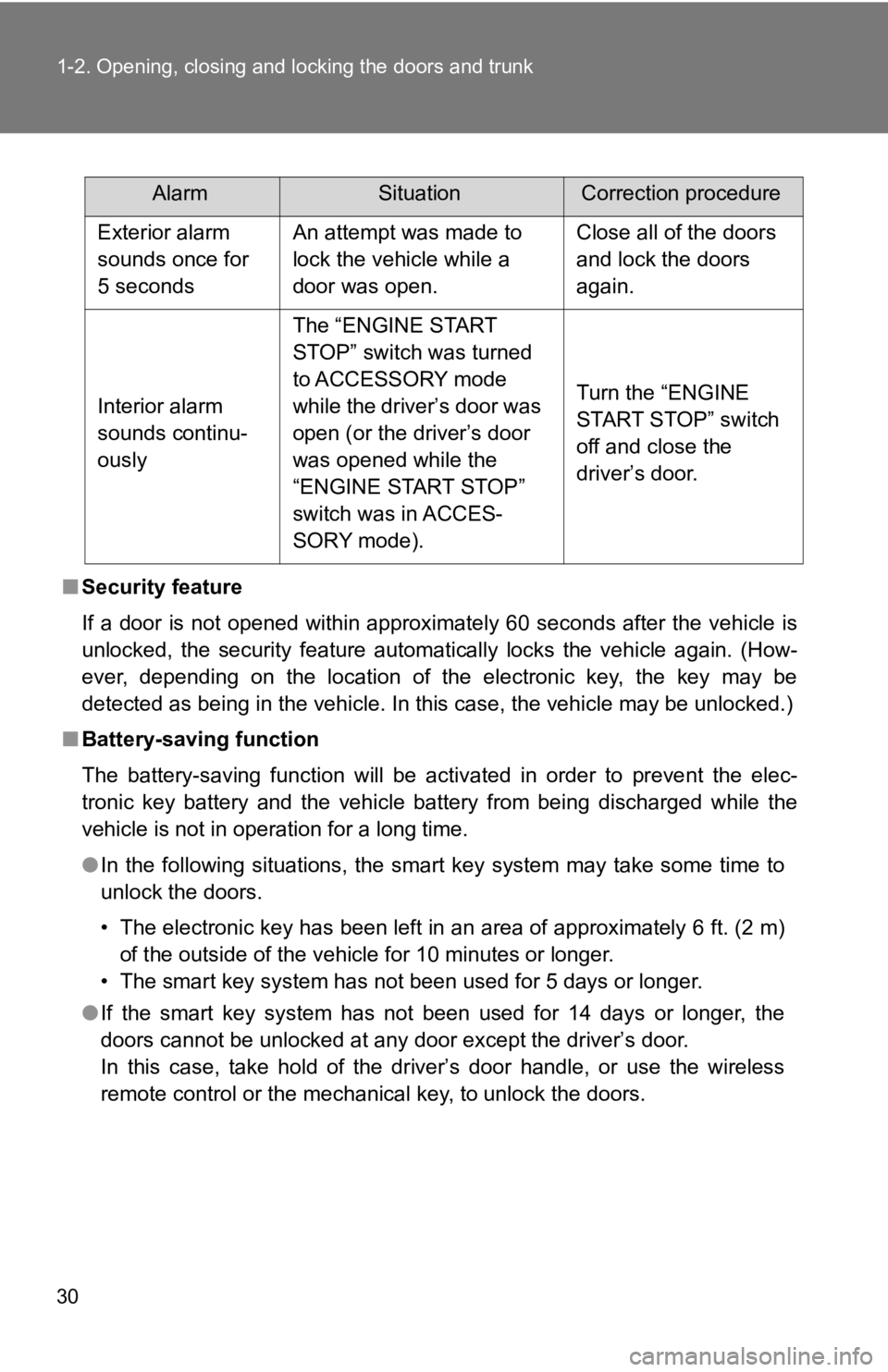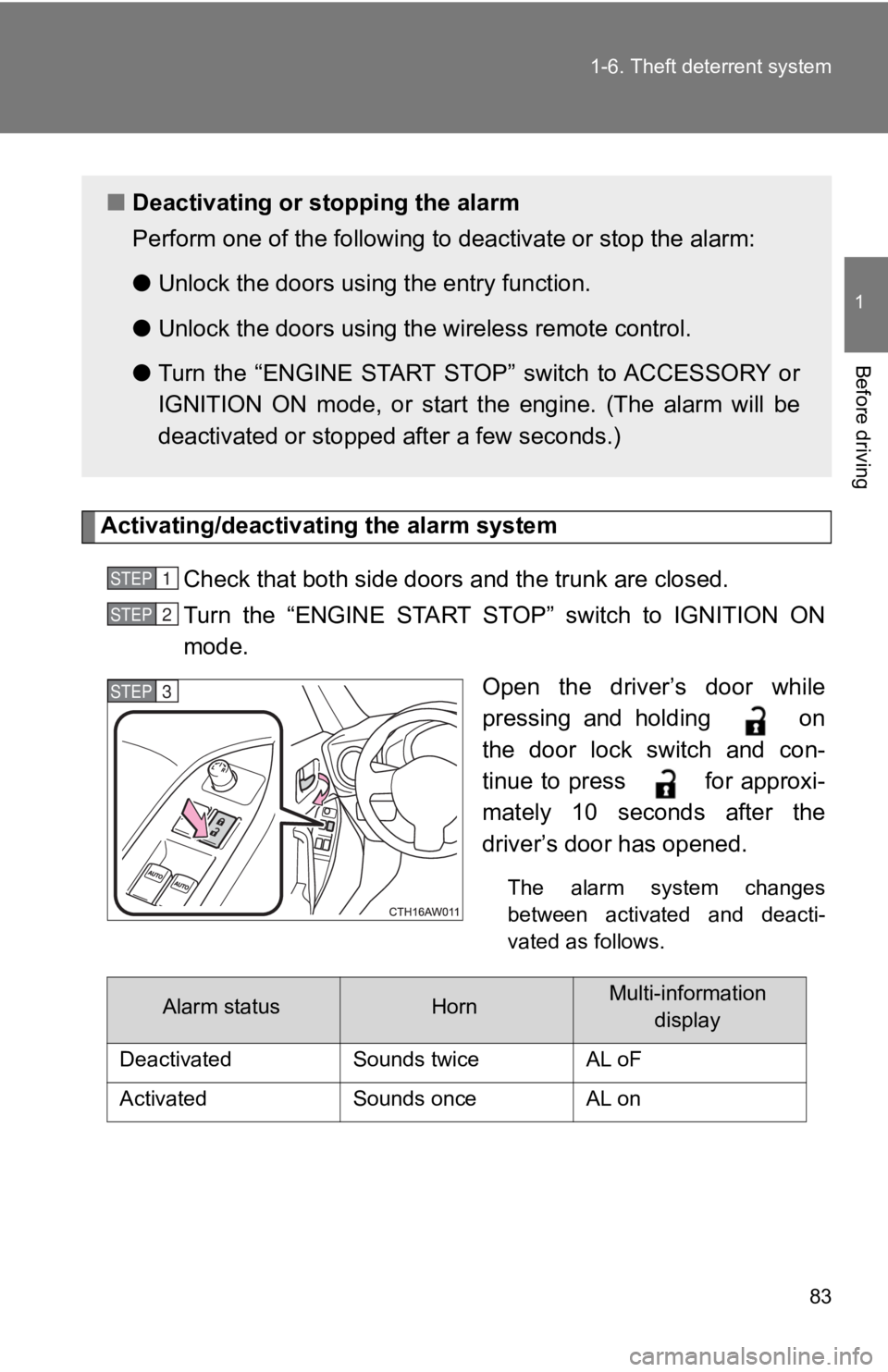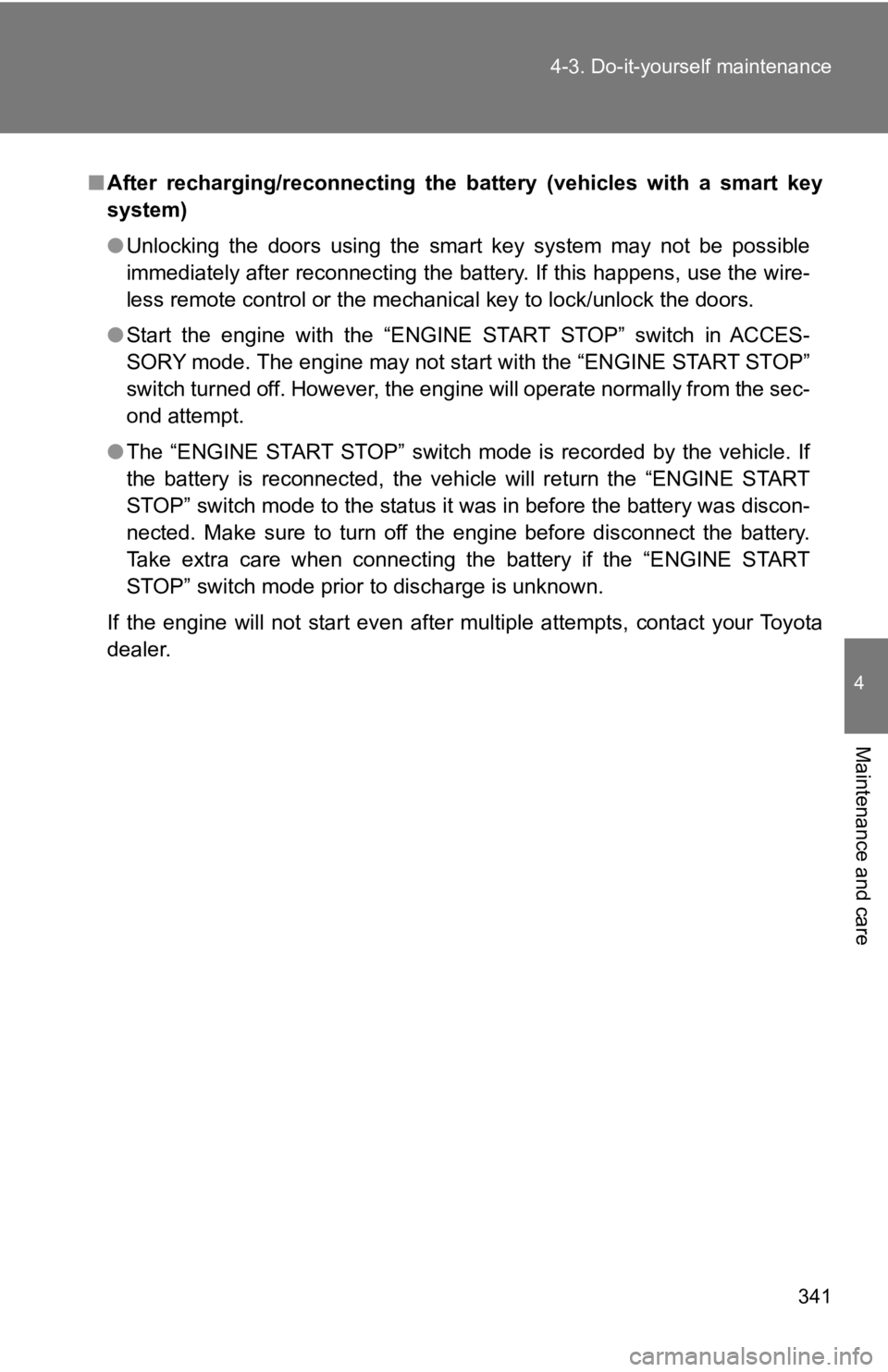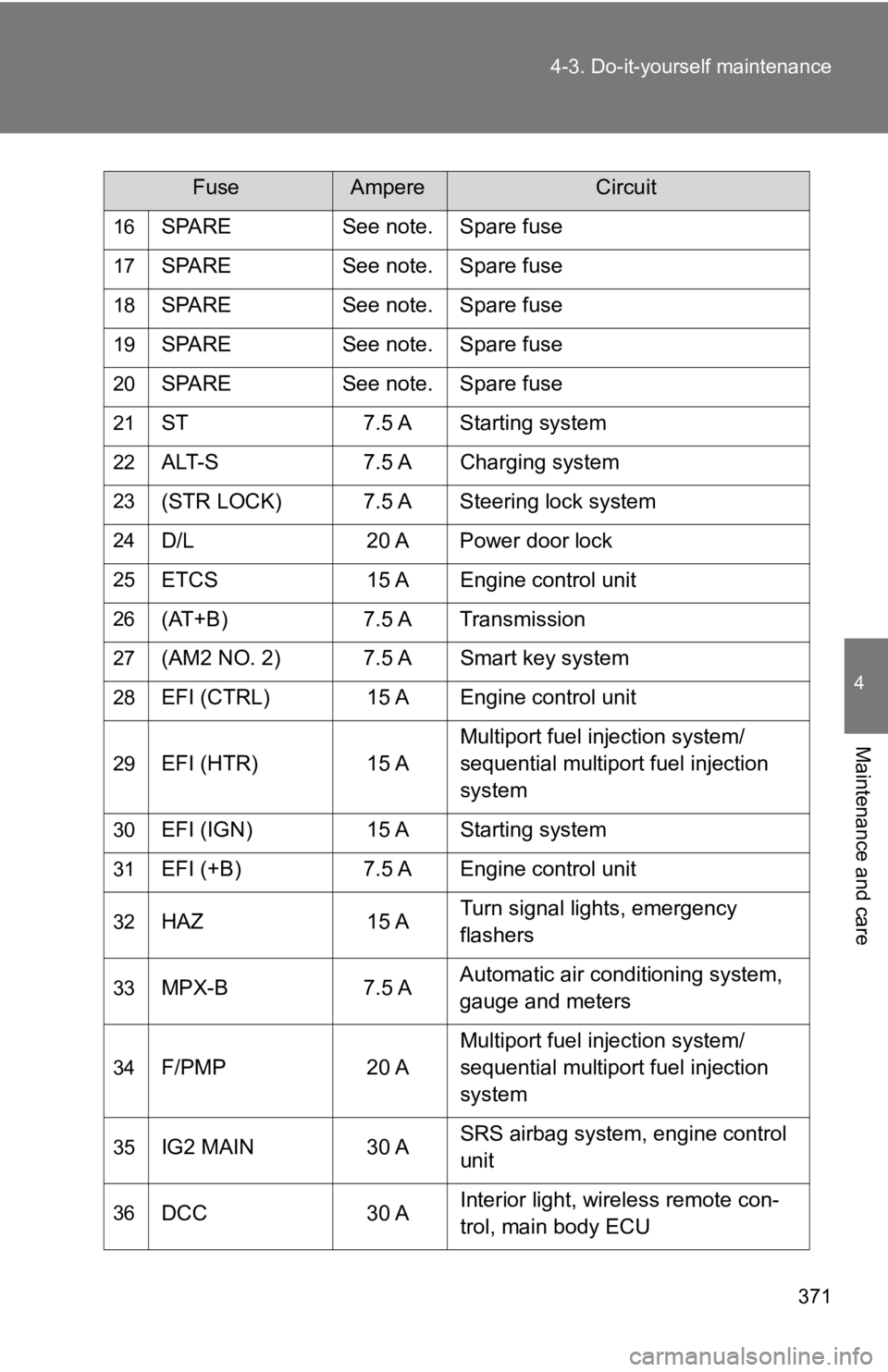remote start TOYOTA 86 2019 Owners Manual
[x] Cancel search | Manufacturer: TOYOTA, Model Year: 2019, Model line: 86, Model: TOYOTA 86 2019Pages: 532, PDF Size: 6.89 MB
Page 19 of 532

19Scrapping of your Toyota The SRS airbag and seat belt pretensioner devices in your Toyot a contain
explosive chemicals. If the vehicle is scrapped with the airbags and seat belt
pretensioners left as they are, this may cause an accident such as fire. Be
sure to have the systems of the SRS airbag and seat belt preten sioner
removed and disposed of by a qualified service shop or by your To y o t a
dealer before you scrap your vehicle.
Perchlorate Material Special handling may apply, See www.dtsc.ca.gov/hazardouswaste/ perchlorate.
Your vehicle has components that may contain perchlorate. These
components may include airbag, seat belt pretensioners, and wir eless
remote control batteries.
WARNING■ General precautions while driving
Driving under the influence: Never drive your vehicle when unde r the influ-
ence of alcohol or drugs that have impaired your ability to ope rate your vehi-
cle. Alcohol and certain drugs delay reaction time, impair judg ment and
reduce coordination, which could lead to an accident that could result in
death or serious injury.
Defensive driving: Always drive defensively. Anticipate mistake s that other
drivers or pedestrians might make and be ready to avoid acciden ts.
Driver distraction: Always give your full attention to driving. Anything that dis-
tracts the driver, such as adjusting controls, talking on a cel lular phone or
reading can result in a collision with resulting death or serio us injury to you,
your occupants or others.
■ General precaution regarding children’s safety
Never leave children unattended in the vehicle, and never allow children to
have or use the key.
Children may be able to start the vehicle or shift the vehicle into neutral.
There is also a danger that children may injure themselves by p laying with
the windows or other features of the vehicle. In addition, heat build-up or
extremely cold temperatures inside the vehicle can be fatal to children.
Page 30 of 532

301-2. Opening, closing and locking the doors and trunk
■ Security feature
If a door is not opened within approximately 60 seconds after t he vehicle is
unlocked, the security feature automatically locks the vehicle again. (How-
ever, depending on the location of the electronic key, the key may be
detected as being in the vehicle. In this case, the vehicle may be unlocked.)
■ Battery-saving function
The battery-saving function will be activated in order to preve nt the elec-
tronic key battery and the vehicle battery from being discharge d while the
vehicle is not in operation for a long time.
● In the following situations, the smart key system may take some time to
unlock the doors.
• The electronic key has been left in an area of approximately 6 ft. (2 m)
of the outside of the vehicle for 10 minutes or longer.
• The smart key system has not been used for 5 days or longer.
● If the smart key system has not been used for 14 days or longer , the
doors cannot be unlocked at any door except the driver’s door.
In this case, take hold of the driver’s door handle, or use the wireless
remote control or the mechanical key, to unlock the doors. Alarm Situation Correction procedure
Exterior alarm
sounds once for
5 seconds An attempt was made to
lock the vehicle while a
door was open. Close all of the doors
and lock the doors
again.
Interior alarm
sounds continu-
ously The “ENGINE START
STOP” switch was turned
to ACCESSORY mode
while the driver’s door was
open (or the driver’s door
was opened while the
“ENGINE START STOP”
switch was in ACCES-
SORY mode). Turn the “ENGINE
START STOP” switch
off and close the
driver’s door.
Page 32 of 532

321-2. Opening, closing and locking the doors and trunk
■ Notes for the entry function
● Even when the electronic key is within the effective range (detection
areas), the system may not operate properly in the following ca ses:
• The electronic key is too close to the window or outside door handle,
near the ground, or in a high place when the doors are locked o r
unlocked.
• The electronic key is near the ground or in a high place, or t oo close to
the rear bumper center when the trunk is unlocked.
• The electronic key is on the instrument panel, rear shelf or f loor, in the
door pockets or glove box, auxiliary box when the engine is sta rted or
“ENGINE START STOP” switch modes are changed.
● Do not leave the electronic key on top of the instrument panel or near the
door pockets when exiting the vehicle. Depending on the radio w ave
reception conditions, it may be detected by the antenna outside the cabin
and the door will become lockable from the outside, possibly tr apping the
electronic key inside the vehicle.
● As long as the electronic key is within the effective range, th e doors may
be locked or unlocked by anyone.
● Even if the electronic key is not inside the vehicle, it may be possible to
start the engine if the electronic key is near the window.
● The doors may unlock if a large amount of water splashes on the door
handle, such as in the rain or in a car wash when the electroni c key is
within the effective range. (The door will automatically be loc ked after
approximately 60 seconds if the doors are not opened and closed .)
● Gripping the door handle when wearing a glove may not unlock th e door.
● If the wireless remote control is used to lock the doors when t he elec-
tronic key is near the vehicle, there is a possibility that the door may not
be unlocked by the entry function. (Use the wireless remote con trol to
unlock the doors.)
● A sudden approach to the effective range or door handle may prevent the
doors from being unlocked. In this case, return the door handle to the
original position and check that the doors unlock before pullin g the door
handle again.
Page 35 of 532

351-2. Opening, closing and locking the doors and trunk
1
Before driving ■ Electronic key battery depletion
● The standard battery life is 1 to 2 years.
● If the battery charge becomes low, a buzzer will sound in the c abin and a
message will be displayed on the multi-information display when the
engine is stopped. ( P. 413)
● As the electronic key always receives radio waves, the battery will
become depleted even if the electronic key is not used. The fol lowing
symptoms indicate that the electronic key battery may be depleted.
Replace the battery when necessary. ( P. 363)
• The smart key system or the wireless remote control does not o perate.
• The detection area becomes smaller.
• The LED indicator on the key surface does not turn on.
● To avoid serious deterioration, do not leave the electronic key close to
any of the following electrical appliances that produce a magne tic field:
•TVs
• Personal computers
• Cellular phones, cordless phones and battery chargers
• Recharging cellular phones or cordless phones
• Induction cookers
• Table lamps
■ When the electronic key battery is fully depleted
P. 363
■ If the smart key system has been d eactivated in a customized se tting
● Locking and unlocking the doors, unlocking the trunk: Use the w ireless
remote control or mechanical key. ( P. 38, 440)
● Starting the engine and changing “ENGINE START STOP” switch
modes: P. 4 4 1
● Stopping the engine: P. 443
■ Customization that can be configured at Toyota dealer
Settings (e.g. smart key system) can be changed.
(Customizable features: P. 487)
Page 83 of 532

831-6. Theft deterrent system
1
Before driving
Activating/deactivating the alarm system
Check that both side doors and the trunk are closed.
Turn the “ENGINE START STOP” switch to IGNITION ON
mode.
Open the driver’s door while
pressing and holding on
the door lock switch and con-
tinue to press for approxi-
mately 10 seconds after the
driver’s door has opened. The alarm system changes
between activated and deacti-
vated as follows.■ Deactivating or s topping the alarm
Perform one of the following to deactivate or stop the alarm:
● Unlock the doors using the entry function.
● Unlock the doors using the wireless remote control.
● Turn the “ENGINE START STOP” switch to ACCESSORY or
IGNITION ON mode, or start t he engine. (The alarm will be
deactivated or stopped after a few seconds.) STEP 1
STEP 2
STEP 3
Alarm status Horn Multi-information
display
Deactivated Sounds twice AL oF
Activated Sounds once AL on
Page 341 of 532

3414-3. Do-it-yourself maintenance
4
Maintenance and care ■ After recharging/reconnecting the battery (vehicles with a smar t key
system)
● Unlocking the doors using the smart key system may not be possi ble
immediately after reconnecting the battery. If this happens, use the wire-
less remote control or the mechanical key to lock/unlock the do ors.
● Start the engine with the “ENGINE START STOP” switch in ACCES-
SORY mode. The engine may not start with the “ENGINE START STOP ”
switch turned off. However, the engine will operate normally from the sec-
ond attempt.
● The “ENGINE START STOP” switch mode is recorded by the vehicle. If
the battery is reconnected, the vehicle will return the “ENGINE START
STOP” switch mode to the status it was in before the battery was discon-
nected. Make sure to turn off the engine before disconnect the battery.
Take extra care when connecting the battery if the “ENGINE STAR T
STOP” switch mode prior to discharge is unknown.
If the engine will not start even after multiple attempts, cont act your Toyota
dealer.
Page 371 of 532

3714-3. Do-it-yourself maintenance
4
Maintenance and care 16
SPARE See note. Spare fuse17
SPARE See note. Spare fuse18
SPARE See note. Spare fuse19
SPARE See note. Spare fuse20
SPARE See note. Spare fuse21
ST 7.5 A Starting system22
ALT-S 7.5 A Charging system23
(STR LOCK) 7.5 A Steering lock system24
D/L 20 A Power door lock25
ETCS 15 A Engine control unit26
(AT+B) 7.5 A Transmission
27
(AM2 NO. 2) 7.5 A Smart key system
28
EFI (CTRL) 15 A Engine control unit
29
EFI (HTR) 15 A Multiport fuel injection system/
sequential multiport fuel injection
system
30
EFI (IGN) 15 A Starting system
31
EFI (+B) 7.5 A Engine control unit
32
HAZ 15 A Turn signal lights, emergency
flashers
33
MPX-B 7.5 A Automatic air conditioning system,
gauge and meters
34
F/PMP 20 A Multiport fuel injection system/
sequential multiport fuel injection
system
35
IG2 MAIN 30 A SRS airbag system, engine control
unit
36
DCC 30 A Interior light, wireless remote con-
trol, main body ECUFuse Ampere Circuit
Page 372 of 532

3724-3. Do-it-yourself maintenance
Note
One of each of the following spare fuses are provided: 7.5 A, 10 A, 15
A, 20 A, 25 A, 30 A. 37
HORN NO. 2 7.5 A Horn38
HORN NO. 1 7.5 A Horn39
H-LP LH LO 15 A Left-hand headlight (low beam)40
H-LP RH LO 15 A Right-hand headlight (low beam)41
H-LP LH HI 10 A Left-hand headlight (high beam)42
H-LP RH HI 10 A Right-hand headlight (high beam)
43
INJ 30 A Multiport fuel injection system/
sequential multiport fuel injection
system44
H-LP WASHER 30 A
45
AM2 NO. 1 40 A Starting system, engine control unit
46
EPS 80 A Electric power steering
47
A/B MAIN 15 A SRS airbag system
48
ECU-B 7.5 A Wireless remote control, main body
ECU
49
DOME 20 A Interior light
50
IG2 7.5 A Engine control unitFuse Ampere Circuit
Page 446 of 532

4465-2. Steps to take in an emergency
■ Starting the engine when the battery is discharged
The engine cannot be started by push-starting.
■ Avoiding a discharged battery
● Turn off the headlights and the air conditioning system while t he engine is
off.
● Turn off any unnecessary electrical components when the vehicle is run-
ning at a low speed for an extended period, such as in heavy tr affic, etc.
■ Charging the battery
The electricity stored in the battery will discharge gradually even when the
vehicle is not in use, due to natural discharge and the draining effects of cer-
tain electrical appliances. If the vehicle is left for a long t ime, the battery may
discharge, and the engine may be unable to start. (The battery recharges
automatically during driving.)
■ Precautions when the battery is discharged (vehicles with a sma rt key
system)
● In some cases, it may not be possible to unlock the doors using the smart
key system when the battery is discharged. Use the wireless remote con-
trol or the mechanical key to lock or unlock the doors.
● The engine may not start on the first attempt after the battery has
recharged but will start normally after the second attempt. Thi s is not a
malfunction.
● The “ENGINE START STOP” switch mode is memorized by the vehicle .
When the battery is reconnected, the system will return to the mode it
was in before the battery was discharged. Before disconnecting the bat-
tery, turn the “ENGINE START STOP” switch off.
If you are unsure what mode the “ENGINE START STOP” switch was in
before the battery discharged, be especially careful when reconnecting
the battery.